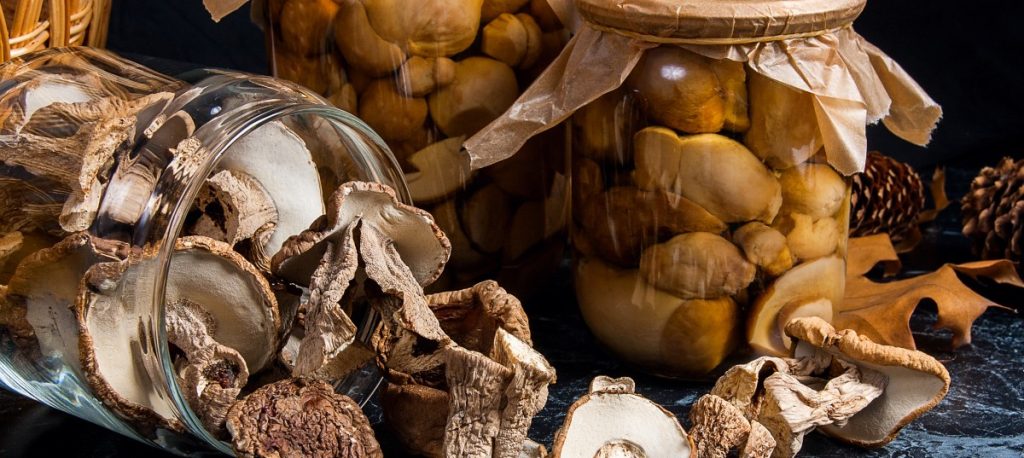Fresh mushrooms are a tasty treat and provide numerous health benefits. But many delicious gourmet mushrooms are difficult to cultivate and only found seasonally.
Other popular, easy to cultivate, edible mushrooms sometimes fruit simultaneously, providing mushroom growers with more fresh mushrooms than they can use.
These scenarios make you wonder, “Can you preserve fresh mushrooms?” and, fortunately, you can.
There are several ways to preserve fresh mushrooms that prevent waste and allow people to enjoy the flavors of gourmet mushrooms throughout the year.
In this article, we cover when and how to preserve fresh mushrooms and provide step-by-step guides to popular mushroom preservation techniques.

Why Preserve Mushrooms?
Mushrooms are delicious and nutritious, but unfortunately, they don’t stay fresh for very long.
Mature mushrooms produce enzymes that cause them to degrade. Storing them at a lower temperature, such as in a refrigerator, will help to slow down the decay.
And, preserving them provides benefits such as:
- Extending the shelf life of fresh mushrooms
- Allowing you to make use of excess mushrooms when you have a bumper harvest
- Providing access to scarce seasonal mushrooms all year round
- Creating additional products for a mushroom business
- Allowing people to access the nutritional and medicinal benefits of mushrooms in different ways
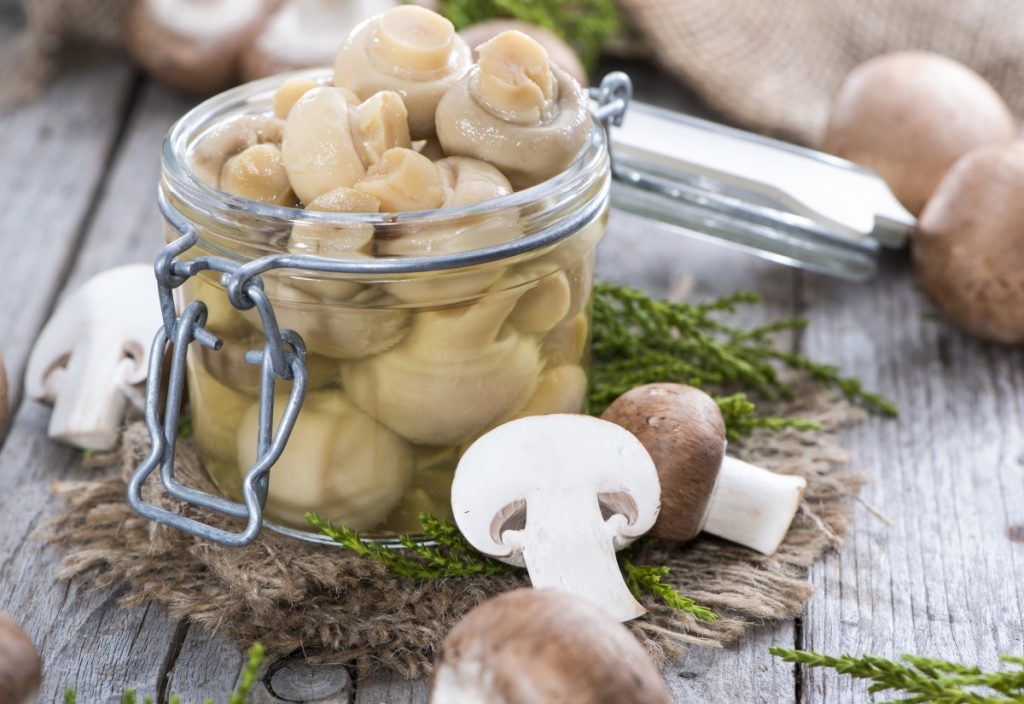
When Should You Preserve Mushrooms?
The best time to preserve mushrooms is when they’re still firm and fresh before they show signs of aging and go bad.
When you come across delicious gourmet mushrooms at your local store or farmers’ market, they can be difficult to resist.
And, when you discover loads of delicious mushrooms while foraging in the wild, it can mean coming home with more mushrooms than you need.
So, when you give in to the impulse to buy or collect more mushrooms than you need, make sure you have time available to preserve them the same or next day.
Because even when you store fresh mushrooms correctly, they don’t last long before they begin to degrade.
And, here’s a fun mushroom fact. If you collect shaggy ink cap mushrooms, you have even less time. This is because picking them triggers auto-digestion and within 24 hours, they devour themselves.
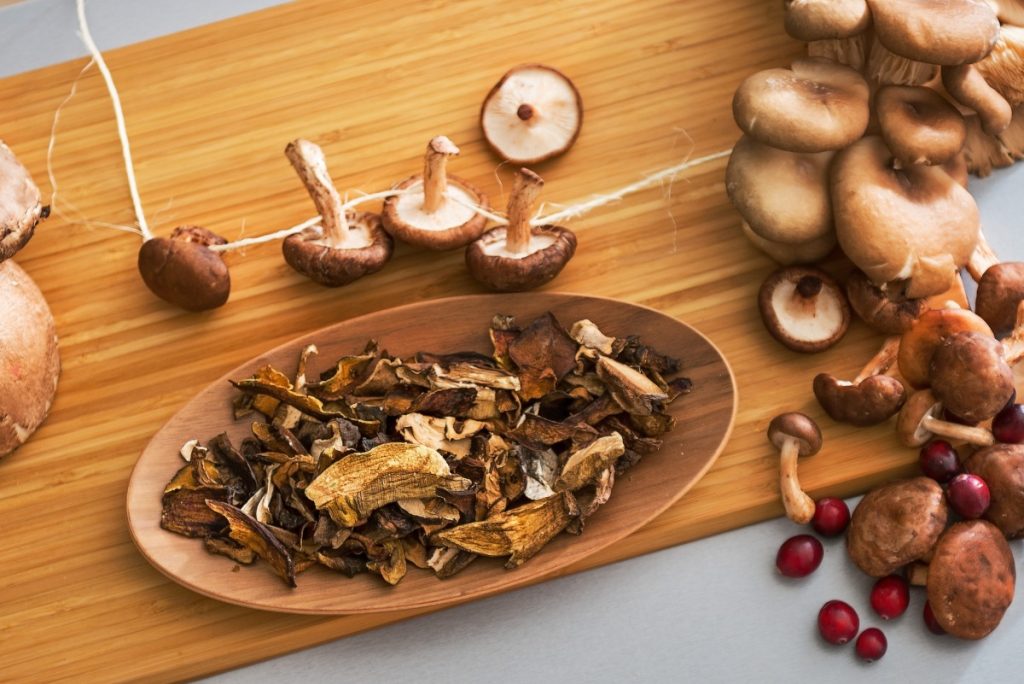
How Long Do Mushrooms Last?
At room temperatures, most mushrooms will only stay fresh for about a day before they start to shrivel, discolor or become slimy.
How you handle, clean and store your mushrooms impacts how long they last.
How Long Do Mushrooms Last in The Fridge?
Whole, fresh mushrooms can last for up to seven days in the fridge. Storing fresh mushrooms in the refrigerator is a good option for short-term preservation.
Lower temperatures help slow down decay and prevent bacteria from forming.
Our article, “How Long Do Mushrooms Last? Everything You Need To Know” has more information on how to store mushrooms in the fridge so that they’ll last longer.
Can You Freeze Mushrooms?
If you’re wondering, “Can mushrooms be frozen for later use?” The answer is yes, you can freeze mushrooms. It’s one of the most popular ways to preserve mushrooms, and they last for up to 12 months in the freezer.
You can freeze mushrooms whole or sliced and either raw, blanched or sauteed. Which method you choose will depend on the type of mushroom and how you plan on using them in the future.
It’s best to cook most types of mushrooms before freezing them, but some are fine to freeze raw.
For example, you can freeze button, cremini or portobello mushrooms, raw or cooked, and wild hen of the woods and maitake mushrooms freeze well when raw.
Our article, “Can You Freeze Mushrooms? Yes! Here’s How!” has more information on freezing mushrooms.
Refrigeration and freezing are popular methods but they’re not the only ways to preserve excess fresh mushrooms.
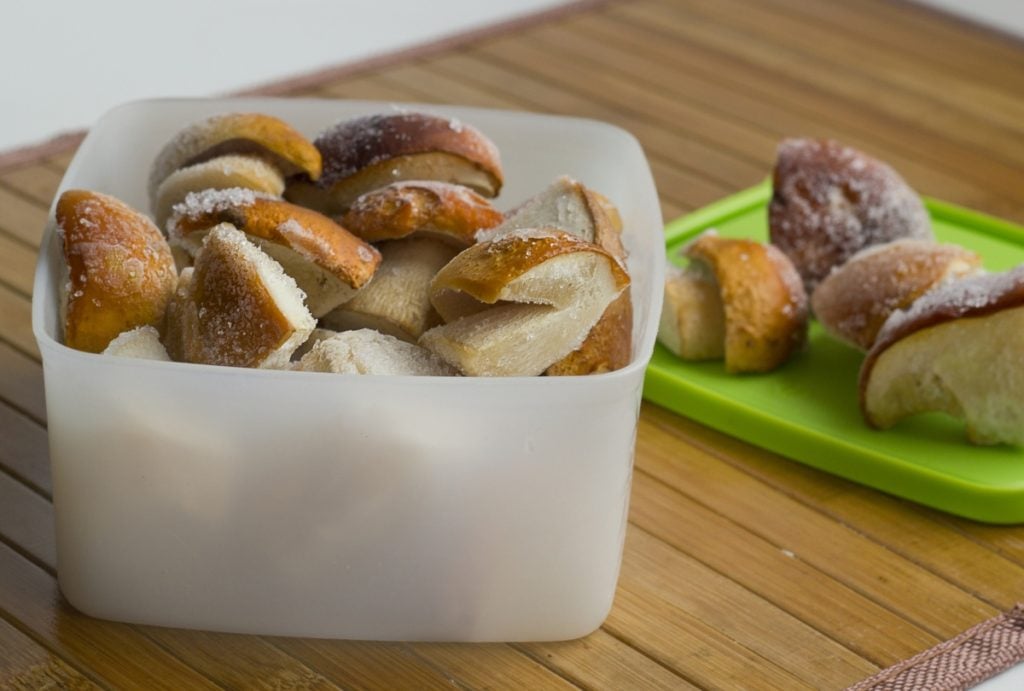
How to Preserve Mushrooms: 13 Different Ways
There are numerous ways to preserve fresh mushrooms, some more commonly used than others.
Some methods preserve the mushrooms’ original taste and texture, but others change the consistency and flavor of the mushrooms.
A few are quick and easy, while others take time and may incorporate other ingredients or require learning new skills.
But, they all allow you to enjoy the nutritional and medicinal benefits of mushrooms for longer.
Here are 13 ways to preserve mushrooms:
- Refrigeration
- Freezing
- Drying
- Pickling
- Powdering
- Making extracts
- Making tinctures
- Fermenting
- Confiting
- Smoking
- Salting
- Making mushroom jerky
- Making mushroom ketchup
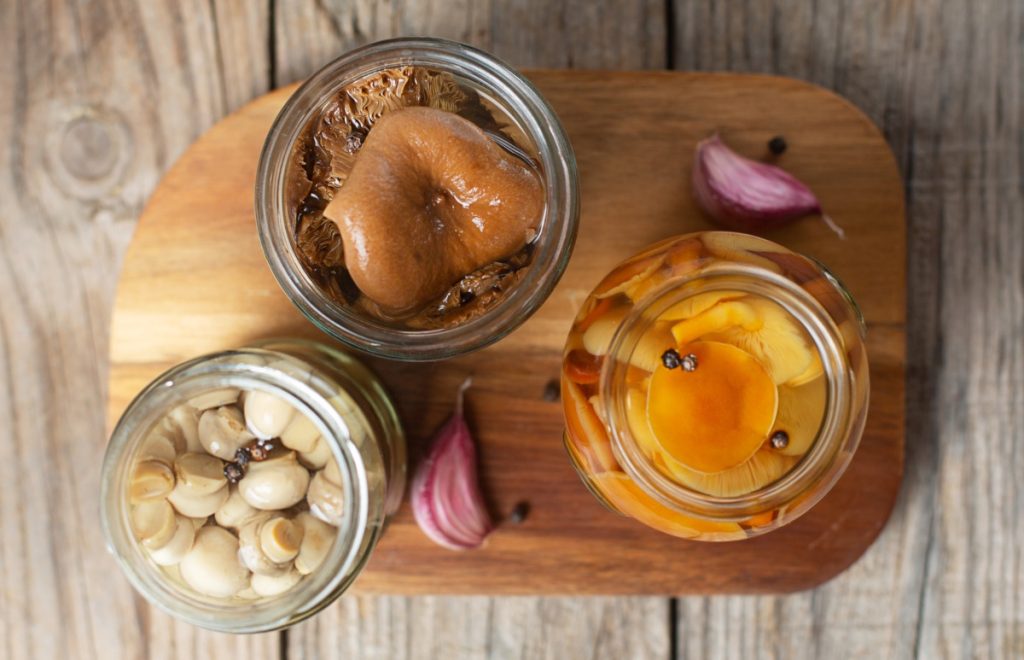
What is The Best Way to Preserve Mushrooms?
The best way to preserve mushrooms will vary from person to person. There are many factors to consider when deciding how to preserve your mushrooms.
Ask yourself the following questions when choosing the best method:
- Do I want to preserve the mushrooms for their flavors or medicinal benefits?
- Do I want to keep the original flavor and texture of the mushrooms as much as possible?
- What preservation methods work well for the type of mushroom I want to preserve?
- How much time do I have available to process and preserve the mushrooms?
- How long do I want the mushrooms to last?
- What do I want to do with the preserved mushrooms?
- Do I want to create a product I can sell?
For most people freezing and drying are the easiest ways to preserve mushrooms. But powders, extracts and tinctures can be a great way to get daily mushroom health benefits.
And pickling, fermenting, confiting, smoking and making jerky or ketchup are great ways to create products to sell or add flavor to daily meals.
Earlier in this article, we discussed refrigerating and freezing mushrooms with links to articles on these preservation techniques.
Below are some step-by-step guides on preserving mushrooms using other popular methods.
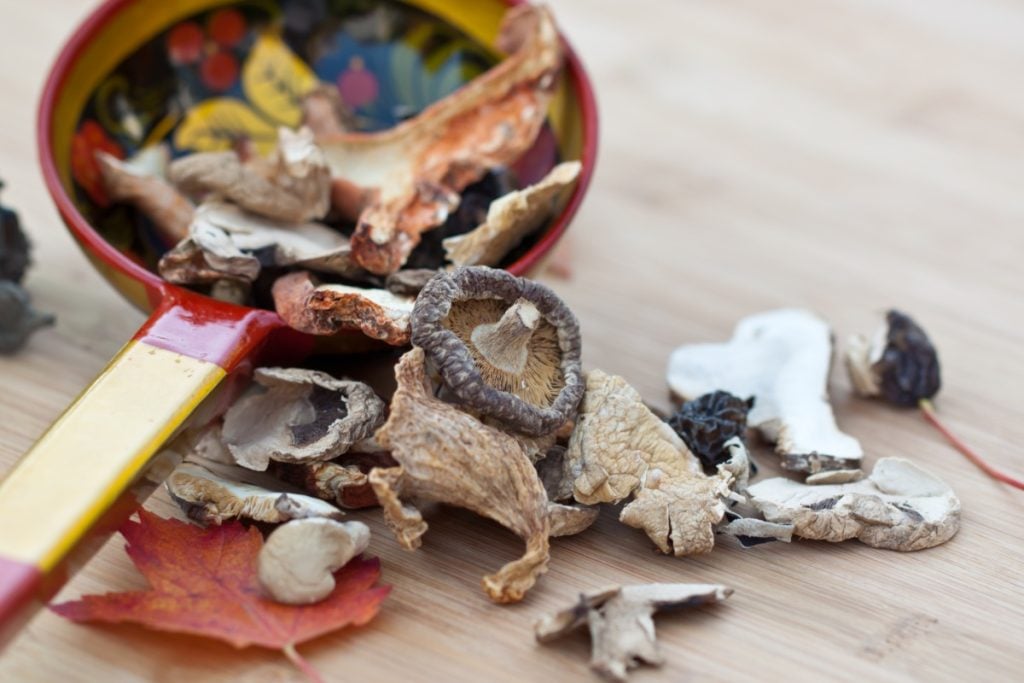
Step-by-Step Guide to Drying Mushrooms
Drying is one of the most popular ways to preserve mushrooms as it accentuates some mushroom species flavors, making them even more intense. Examples of these are shiitake, porcini, morel, black trumpet and matsutake mushrooms.
You can successfully dry most types of mushrooms, but some mushrooms keep their texture better if you freeze them.
Dehydrators are a great way to dry mushrooms, but you can also use an oven or air dry them.
Here are steps to take when drying mushrooms:
Step 1: Cleaning
Depending on how dirty your mushrooms are, cleaning them could involve wiping, brushing or rinsing off dirt and debris.
If the mushrooms have any bruised spots or insect damage, trim these sections off with a sharp knife.
Step 2: Slicing
You don’t always need to slice mushrooms before drying them, but whole mushroom caps and large mushrooms will take longer to dry and may never dry all the way through.
It’s best to slice large mushrooms into quarter or half an inch (0.6 to 1.3 cm) slices.
Step 3: Drying
To dry mushrooms, you need two things, heat and good air circulation.
There are three ways to dry mushrooms:
Air Drying
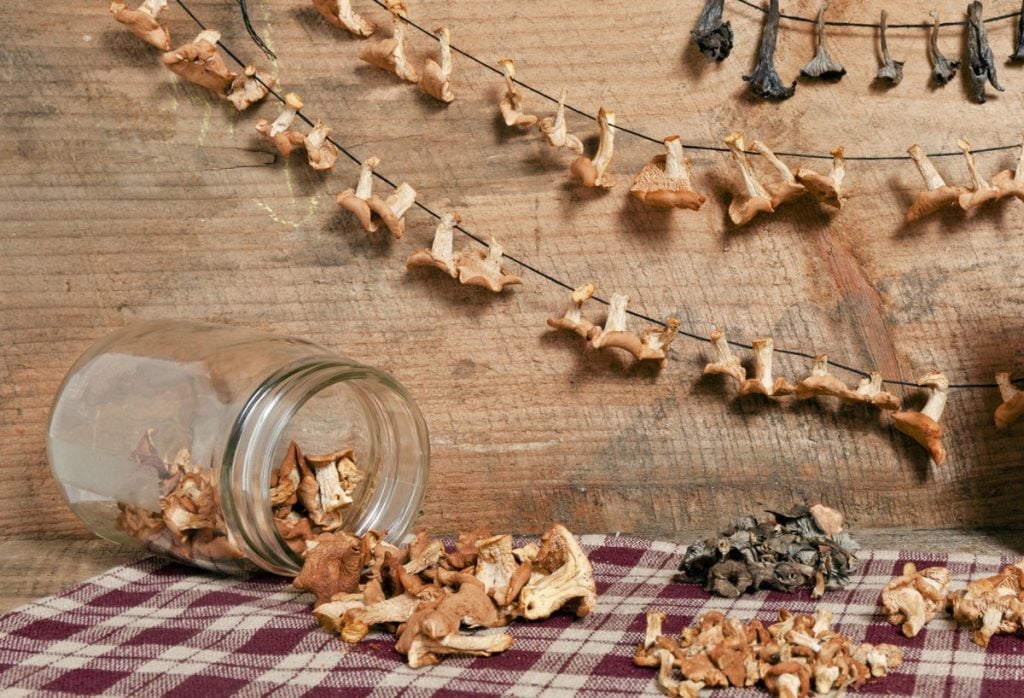
Traditionally people dried mushrooms by threading them onto a string and hanging them up to dry in a warm, airy spot.
You can also dry mushrooms in a wicker basket, bamboo steamer or colander, that allow air circulation underneath the mushrooms.
Put the mushrooms as close together as you can but not overlapping. Then, place the container in a warm, dry location with good air circulation, like a sunny windowsill.
This method will not work well in humid environments as the mushrooms might rot instead of drying.
Oven Drying
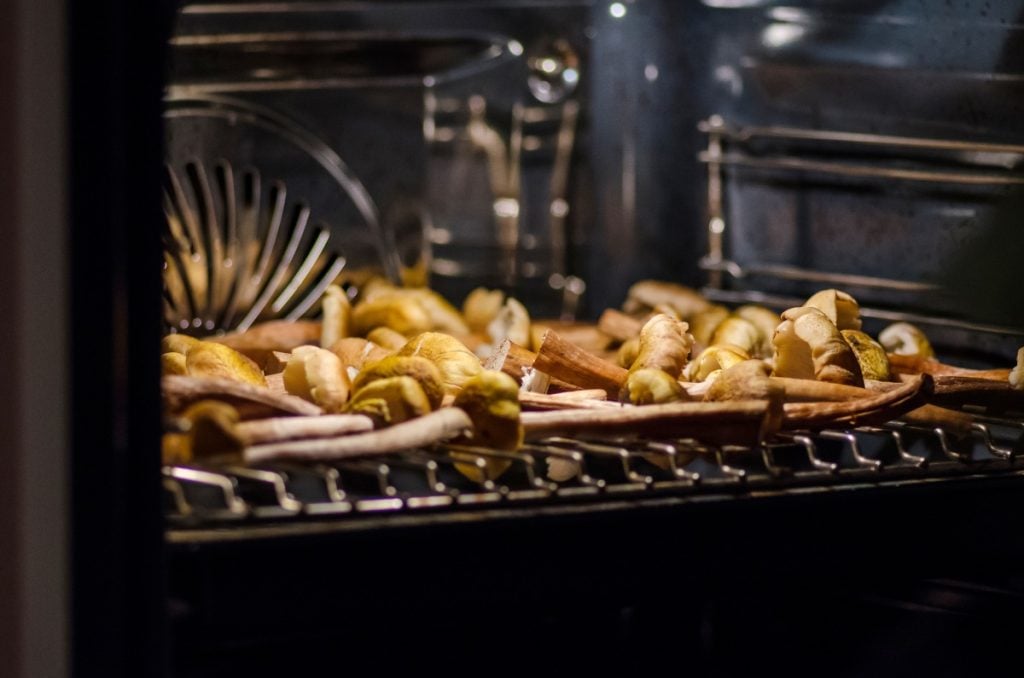
Place your mushrooms in a single layer on an ungreased baking sheet and dry them, turning them over every hour until they are crisp and brittle.
It’s important to use the lowest setting possible and keep the temperature below 150°F (65.5°C). Excessive heat may destroy some of the beneficial compounds in mushrooms.
Using a Dehydrator
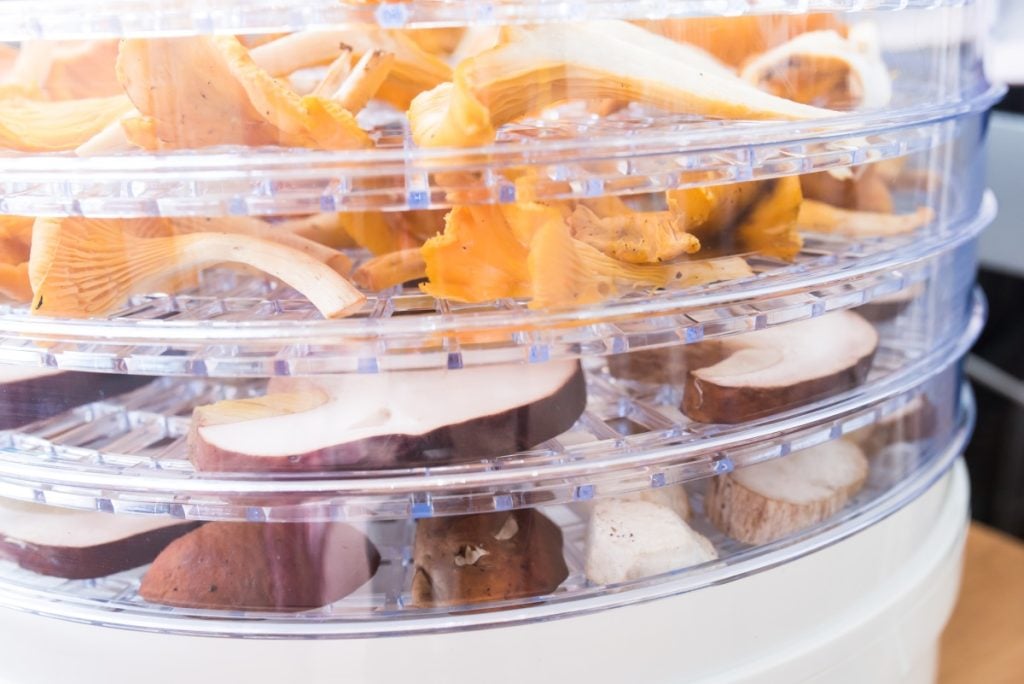
A food dehydrator is an excellent way to dry mushrooms and requires less work than an oven.
Lay the mushrooms out on the dehydrator racks, select a low setting between 110 and 135°F (43 and 57°C), and leave the mushrooms to dry.
Thinner slices could be ready in four to six hours. Thicker pieces, halved mushrooms or mushroom caps may take eight hours or more to dry completely.
Step 4: Storing
When fully dry, your mushrooms should be brittle and snap or break apart easily. If they bend instead of breaking, it’s best to keep drying them.
If you store mushrooms that still contain even a little moisture, they may rot or go moldy.
Store your dried mushrooms in an airtight container in a cool, dark location.
Our article ” How to Dry Mushrooms 4 Different Ways” has more information on how to dry and dehydrate mushrooms.
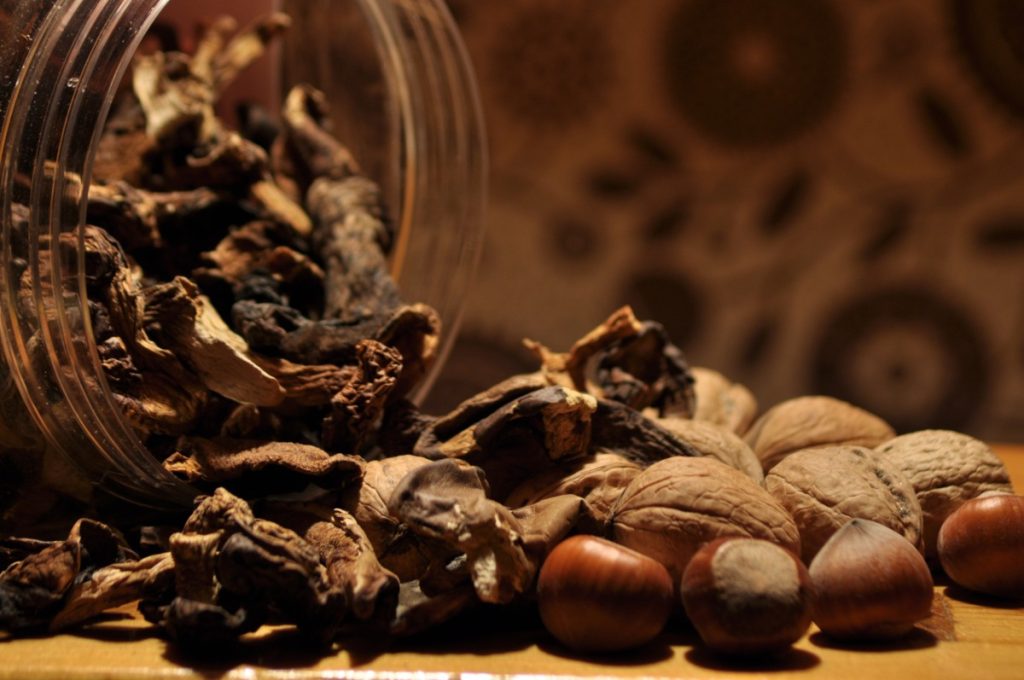
Step by Step Guide to Pickling Mushrooms
People initially developed pickling to preserve fresh produce, and it’s still a popular way to preserve mushrooms.
But, these days, many people choose to pickle mushrooms purely because they enjoy the resulting flavors.
Pickling is not the same as canning, and it can be confusing as many people also can their pickles to make them last longer.
Canning uses heat sterilization to preserve foods, while pickling uses acidity. Mushrooms, like cucumbers, aren’t acidic, so you need to add vinegar when pickling them.
The process for pickling mushrooms is slightly different from other vegetables and uses an oil-and-vinegar-based marinade instead of vinegar and brine.
Follow these steps to pickle your mushrooms:
Step 1: Prepare The Mushrooms
To prepare your mushrooms for pickling, you’ll need to trim off any bruised or damaged sections and clean off loose dirt and debris.
Any mushrooms that have a nice firm texture when cooked are great for pickling, and you can pickle small mushrooms whole.
If you are pickling large mushrooms, slice them lengthways or cut them into chunks that fit into your jar.
Once cleaned, cook your mushrooms. They can be lightly sauteed, boiled or roasted depending on the type of mushroom.
Make sure not to overcook them as you want them to be firm.
Step 2: Make Your Marinade
To make a marinade, combine equal parts of olive oil and your vinegar of choice, around half a cup of each per pound (0.45 kg) of mushrooms. Then add other vegetables if desired and fresh or dried herbs.
There are numerous pickled mushroom recipes that combine different herbs and spices. Many countries have pickled mushroom specialties.
Try a few to see which you prefer, or create your own pickled mushroom recipe using your favorite herbs and spices.
Step 3: Combine Mushrooms And Marinade
Depending on the recipe, you may combine the marinade ingredients with the mushrooms, bring them to a boil together and then place them in a jar.
Or, bring the marinade ingredients to a boil separately and pour them into the jar over the cooked mushrooms.
Once you have combined the mushrooms and marinade and they’re in a jar, seal the jar.
Leave the mushrooms to marinate for at least three days before consuming them.
Pickled mushrooms will last for up to a month in the fridge. But, if you also use heat sterilization, you can store your pickled mushrooms for a year or more in a cool dark place.
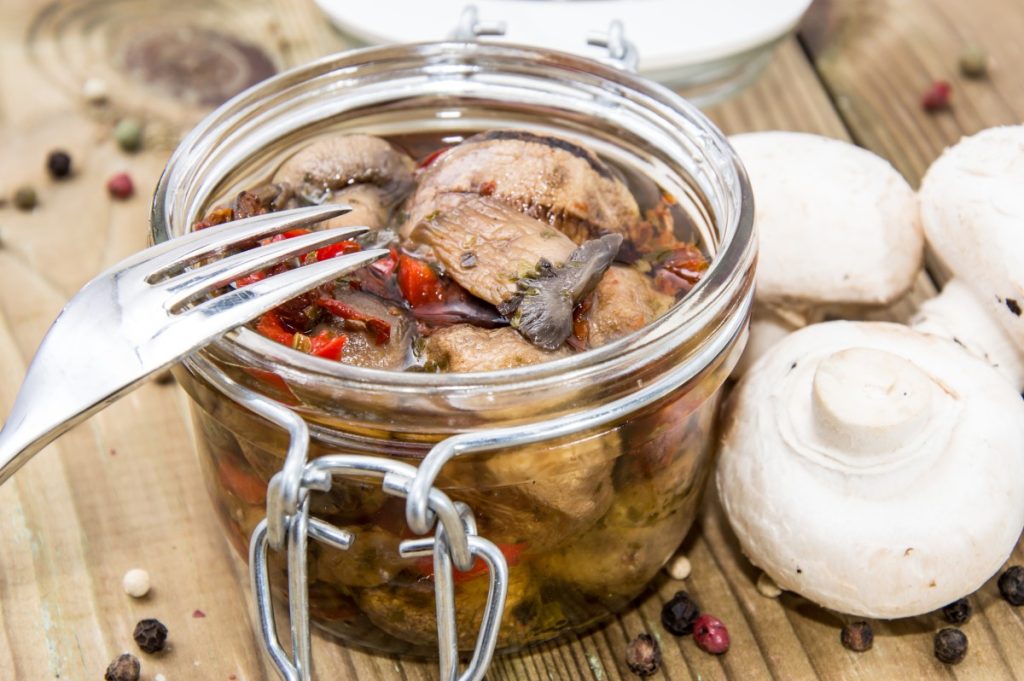
Step by Step Guide to Making Mushroom Tincture
A tincture is a concentrated liquid extract that uses alcohol as one of the solvents to dissolve and extract desirable components from mushrooms and plants.
Many people use a double extraction method to extract as many beneficial compounds from medicinal mushrooms as possible.
Please watch our video below for step-by-step instructions on making medicinal mushrooms tinctures.
Step by Step Guide to Making Mushroom Powder
Mushroom powder is a convenient way to add the health benefits and umami flavors of mushrooms to your dishes when you don’t have time for prepping and cooking fresh or dried mushrooms.
Follow these easy steps to make mushroom powder:
Step 1: Drying
Dry your mushrooms using the step-by-step guide to drying mushrooms above.
Step 2: Grinding
Grind or process the dried mushrooms using a food processor, blender, spice grinder or coffee bean grinder.
When using a food processor or blender, begin by pulsing on and off for 15 to 20 seconds to break up large chunks of mushrooms. Then blend until you have a fine powder.
If you are processing a lot of mushrooms, grind them in batches, only filling the food processor or blender halfway each time.
Step 3: Storing
Mushroom powder lasts best when stored properly, in an airtight container, away from direct light and heat.
You can use a sealed plastic container or zipped plastic bag to store mushroom powder, but an airtight glass jar will ensure maximum shelf life.
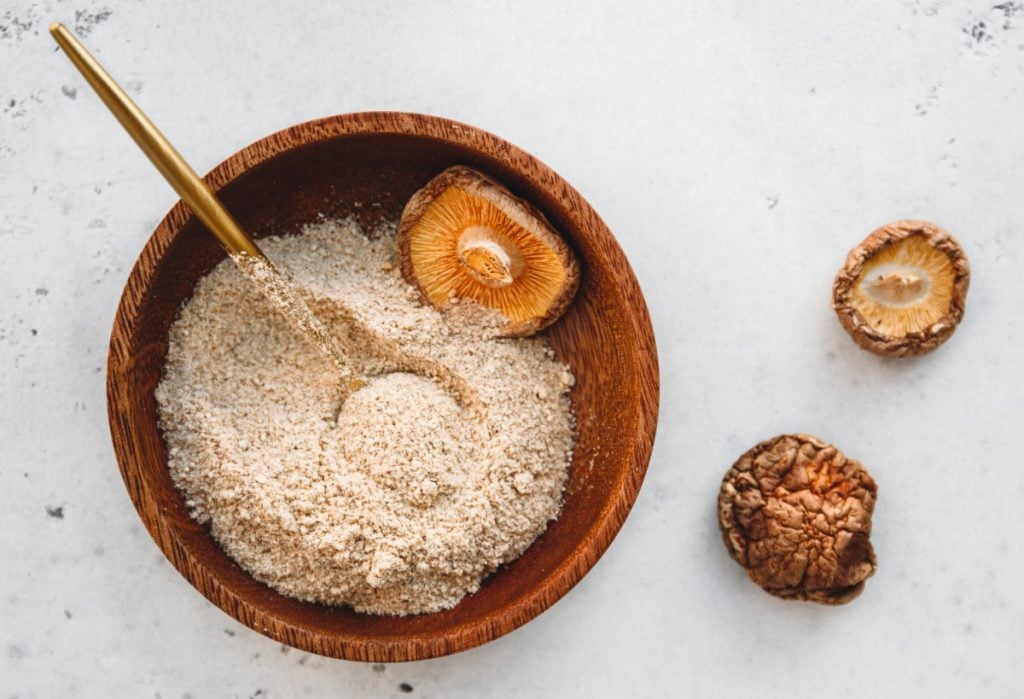
Step by Step Guide to Making Mushroom Jerky
Mushroom jerky is an easy-to-make healthy snack full of minerals, vitamins, antioxidants, and dietary fiber.
It has rich, umami flavors, and as mushrooms soak up the marinade so well, it’s deliciously tasty.
Here are the steps to make mushroom jerky.
Step 1: Mushroom Selection
You can use several types of mushrooms when making jerky, but some are better suited to jerky than others.
It’s advisable to use larger-sized mushrooms as the process will shrink mushrooms by 30 to 50 percent, and you don’t want to end up with tiny pieces of jerky.
Use mushrooms that have distinct flavors to make jerky. So the marinade doesn’t overpower them, and their flavors come through in the end product.
Popular mushrooms for making jerky are shiitake, portobello, oyster and king oyster mushrooms.
Step 2: Cleaning
Clean any loose dirt or debris off your mushrooms by giving them a quick rinse under running water and then patting them dry with a paper towel.
Step 3: Slicing or Tearing
Depending on personal preference, you can slice or tear your mushrooms into smaller pieces.
Slicing takes a little longer but gives you cleaner, more even pieces. Tearing is quick and fun and creates rough edges that mimic beef jerky.
Tearing also creates nooks and crannies that may absorb more marinade.
Step 4: Marinading
There are numerous mushroom jerky marinade recipes available, and you can find one you love or create your own.
When making your jerky marinade, be creative, but remember to include a few key elements: salt, fat, acid and a little sweetness.
Salt is an essential ingredient in mushroom jerky. You can get salt from various sources, but recipes often use sea salt, soy sauce, liquid smoke or Worcestershire sauce.
Rice wine vinegar, apple cider vinegar or lemon juice are great options for the acidic ingredient, and together with the salt, they help the jerky last longer.
An oil brings everything together, and good options include olive oil, grape seed oil or sesame oil. For the touch of sweetness, try brown sugar, honey or maple syrup.
You can marinade your mushrooms in a bowl or a plastic bag. Both options work, but a zipper bag allows you to remove oxygen and helps the marinade penetrate the mushrooms.
Ideally, marinate your mushrooms overnight, and for more flavor, you can leave them for up to 24 hours but no longer, as the marinade will begin to break down the mushrooms.
Step 5: Drying
Dry your mushroom jerky using a dehydrator or an oven.
The thickness and size of your mushrooms and the texture you want will dictate how long it will take to cook or dehydrate the marinated mushrooms.
Follow the instructions in step three of the guide to drying mushrooms above and adjust the times to suit your requirements.
Soft mushroom jerky will take less time, but if you’re after crunchy mushroom jerky, let the mushrooms dry out completely.
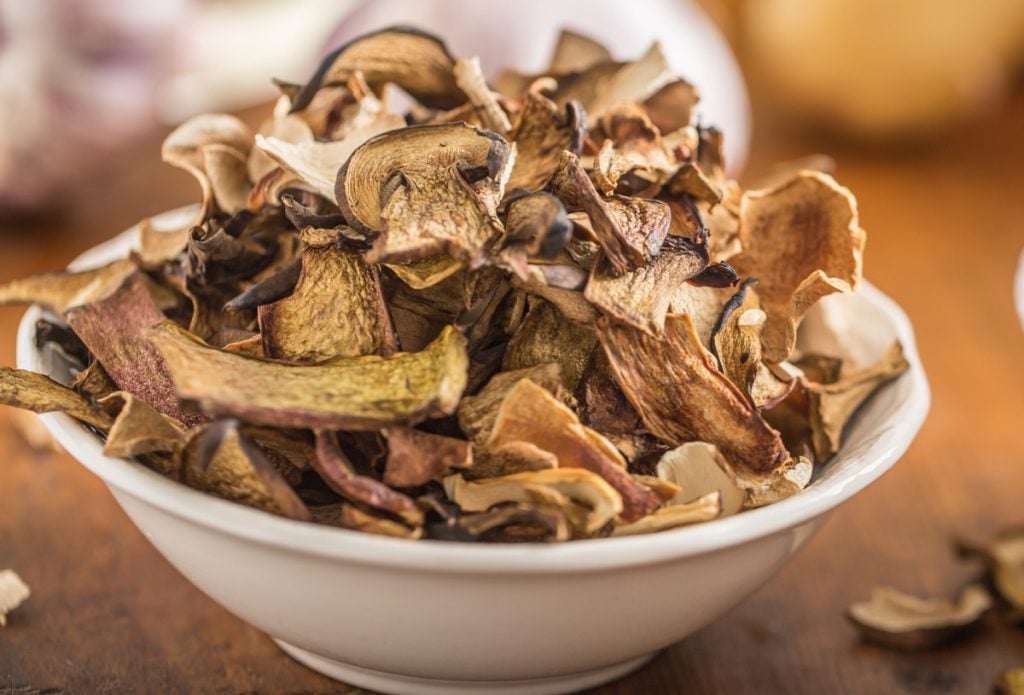
How to Make Mushroom Ketchup
Mushroom ketchup is a smooth sauce that uses mushrooms instead of tomatoes as the base ingredient.
To make mushroom ketchup, marinate mushrooms, mushroom stems or other leftover pieces of mushroom overnight with salt.
The marinated mushrooms are then combined with other ingredients, cooked and blended into a smooth sauce.
Try this MasterClass mushroom ketchup recipe from Gordon Ramsey.
Best Mushrooms to Preserve
Some of the best mushrooms to preserve are also the most expensive, like morels, porcini and chanterelles.
These mushrooms are difficult to cultivate commercially, and you can only find them at certain times of year in the wild.
But, all fresh mushrooms are worth preserving for their health and nutritional benefits, and it’s a shame if any go bad.
Some mushroom species are easier to preserve than others, and different preservation methods are better suited to particular types of mushrooms.
How to Preserve Morel Mushrooms
The best ways to preserve morels are drying or freezing. Many morel mushroom foragers believe that drying morels is the best way to preserve them as they retain their original texture and flavor.
After slicing and cleaning your morels, use any drying method, air, oven or dehydrator to dry them.
While some people feel that freezing morels causes them to lose a bit of their firmness, others argue that freezing them is just as good, if not better, than drying.
But, regardless of which technique you use, avoid using salt when cleaning and preserving morels as this causes them to go soft and limp.
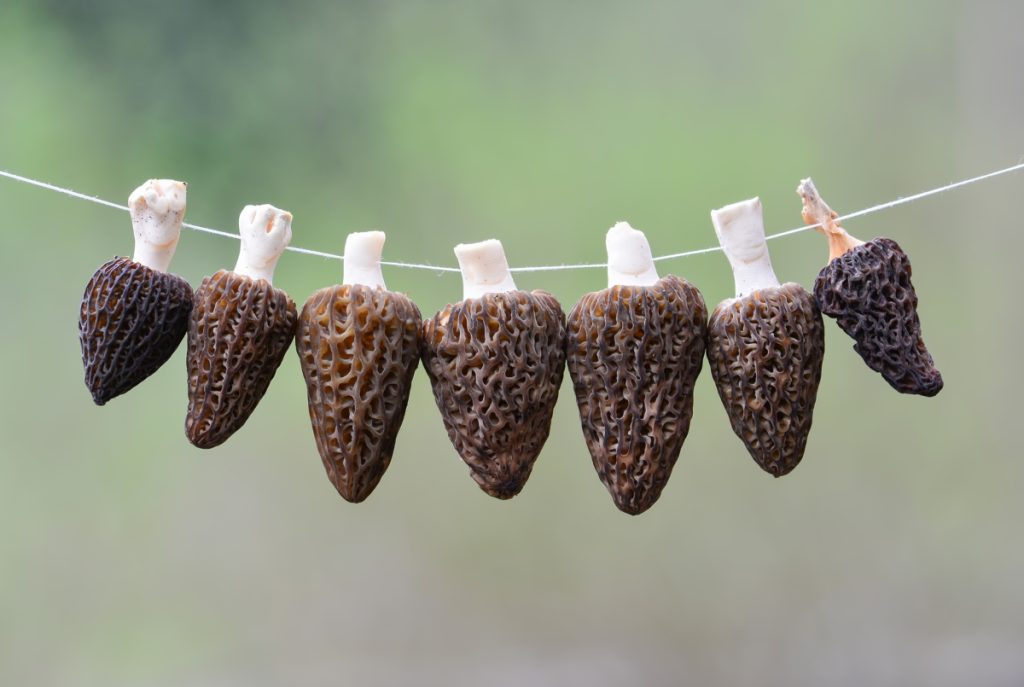
How to Preserve Porcini Mushrooms
The most common method of preserving porcini mushrooms is drying, which people often take a step further to produce versatile porcini mushroom powder.
Dried porcini and porcini powder add delicious umami tastes to your meals, and many chefs feel no kitchen should be without them.
Freezing porcini mushrooms also works well, but is not as commonly used.
The secret to cooking frozen porcini is to take them out of the freezer and put them in the fridge the night before you plan to use them.
The next day put the semi-frozen porcini directly into a hot pan to saute them or onto a preheated roasting pan and quickly into a hot oven.
The result is so similar to fresh porcini that it’s difficult to tell them apart.
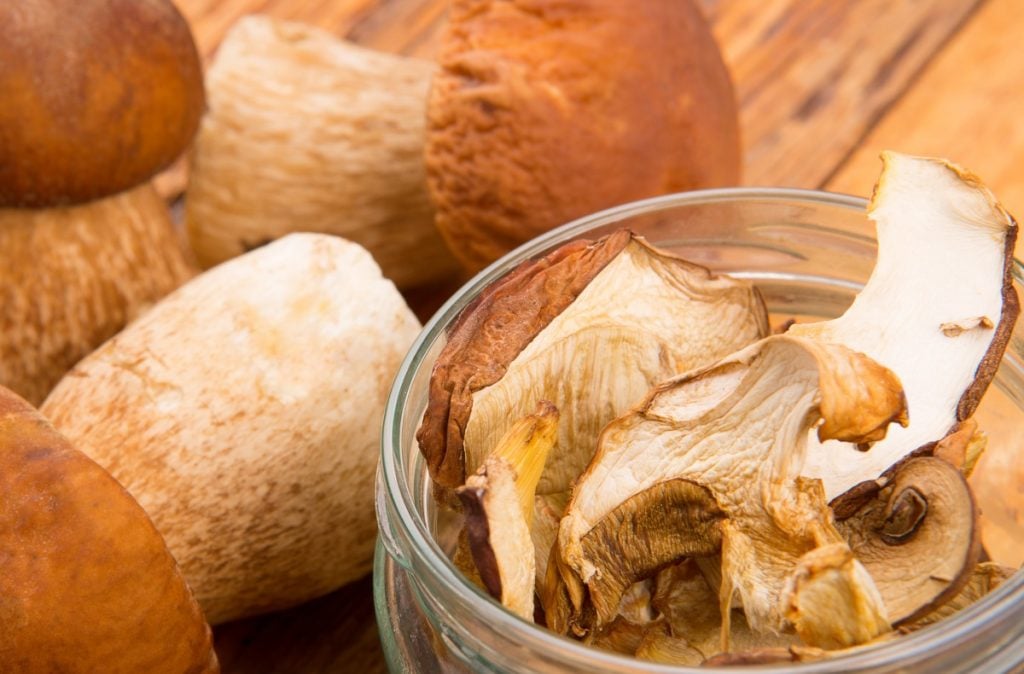
How to Preserve Chanterelle Mushrooms
You can preserve chanterelle mushrooms best by freezing or pickling them. Although many people also dry chanterelles, they may lose some flavor and become tough and chewy using this method.
Freezing is the most popular way of preserving chanterelles, and cooking them first helps retain their flavor and texture best.
Common ways to cook chanterelles before freezing them are steaming, sauteing and dry sauteing.
Pickling is another popular, time-honored way to preserve chanterelles. Pickled chanterelles are delicious served on their own or with toasted slices of sourdough bread.
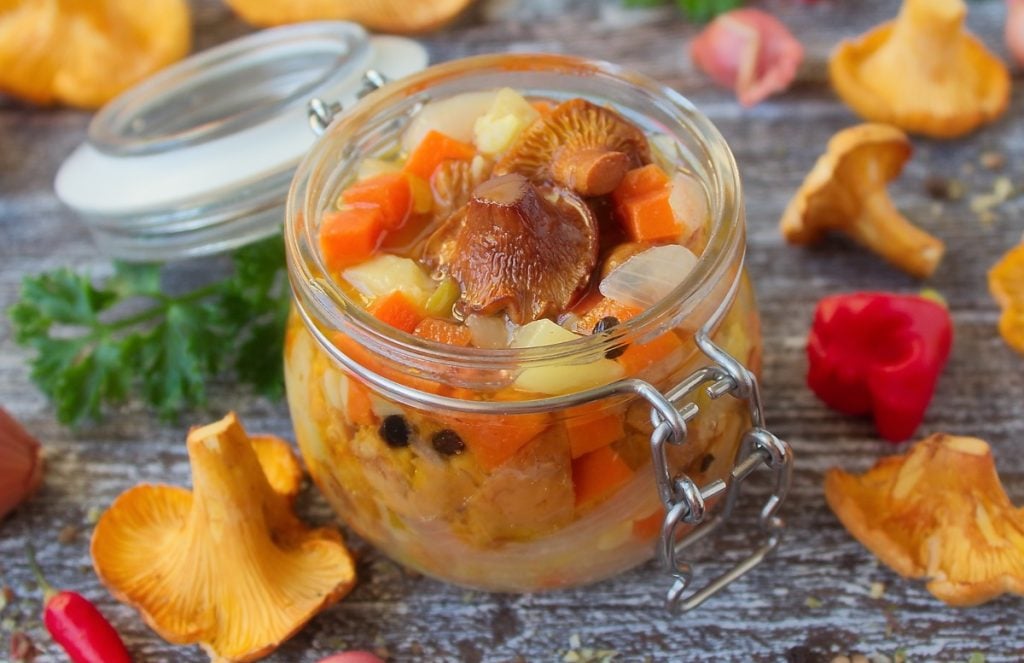
How to Clean Mushrooms Before Preserving Them
A quick rinse in water is the easiest way to clean mushrooms, and unless the mushrooms you have purchased or foraged are exceptionally dirty, it’s all they should need.
Here are the steps to take to clean mushrooms:
Step 1: Trimming
When cleaning dirty wild mushrooms, use a paring knife to trim off crusted dirt and any damaged or bruised sections.
Step 2: Brushing or Rinsing
Depending on the type of mushroom, you can brush off any dirt using a dry pastry brush, toothbrush or paper towel.
But brushing each mushroom is time-consuming, and a rinse under running water is quick and effective and won’t waterlog the mushrooms.
Step 3: Drying
Once you have rinsed your mushrooms under running water, pat them dry with a paper towel or if you’re cleaning delicate mushrooms place them on a paper towel to dry.
No matter what type of mushroom you’re using, only clean them just before you intend to use or preserve them.
And, whenever possible, avoid soaking mushrooms. A quick rinse or dunk is enough for most types of mushrooms.
Our article, “How to Clean Mushrooms: A Step by Step Guide.” has detailed information and step-by-step guides to cleaning different types of mushrooms.
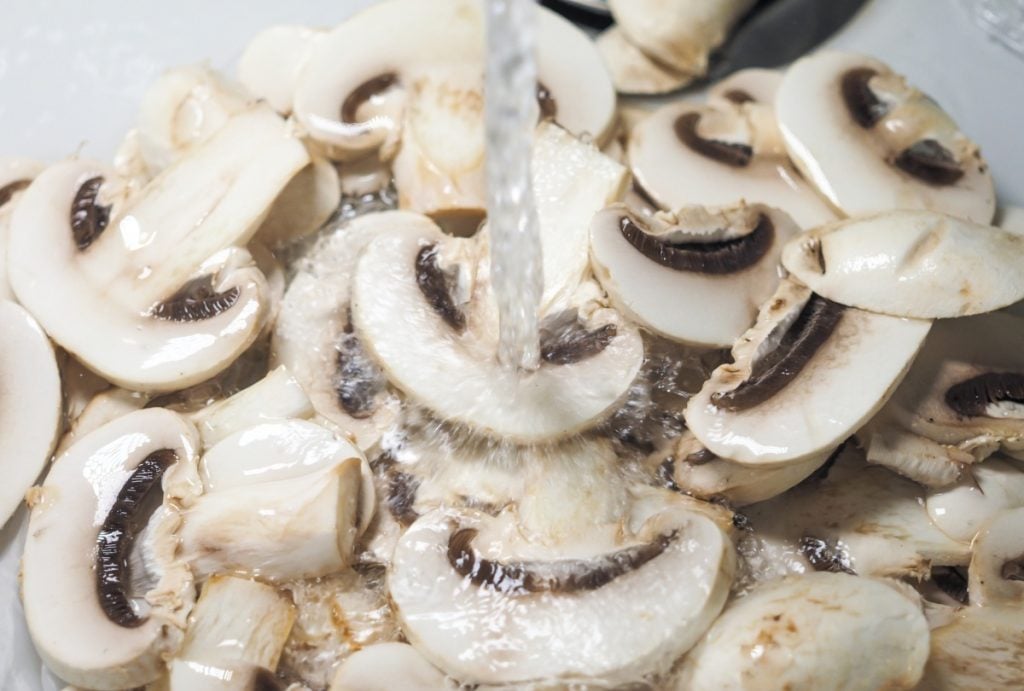
How to Cook With Preserved Mushrooms
When you preserve mushrooms by freezing or drying them, you have an ongoing supply of easy-to-use mushrooms to create delicious mushroom dishes.
Frozen mushrooms are great because you don’t have to defrost them before using them.
Instead, take as many as you need straight from the freezer into a hot saucepan to reheat them.
If making a soup, put frozen mushrooms directly into the warm broth and for pasta sauces, add them still frozen to the crushed tomato in your pot.
Dried mushrooms are a tasty treat as the drying process condenses and intensifies the flavors of the mushrooms.
Before using dried mushrooms, you need to reconstitute them by soaking them in water. This process produces delicious mushrooms and tasty mushroom-flavored liquid.
You can use both to add flavor and nutrients to soups, sauces, stews, and gratins.
The dried mushroom soup recipe below is easy to make and uses both, creating rich mushroom flavors.
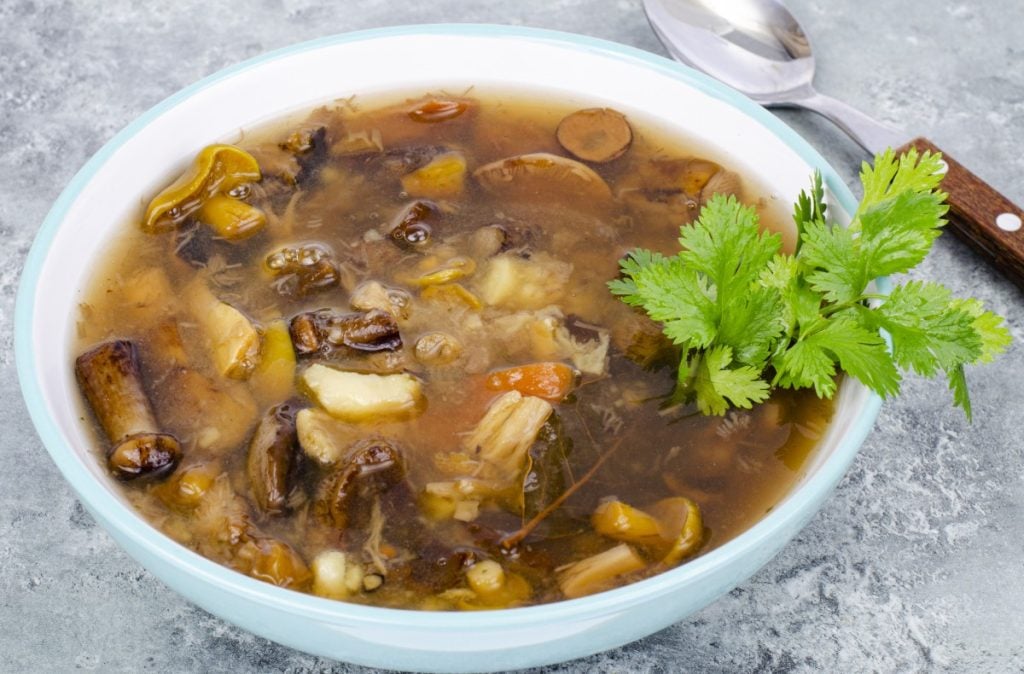
Russian Dried Mushroom Soup
Russians often serve this dried mushroom soup as part of a Russian Christmas Eve supper.
You can use any dried mushrooms to make this soup, providing endless variations.
Ingredients
- 2 cups dried mushrooms
- 8 cups cold water
- 1 teaspoon salt, or to taste
- 1 clove garlic, or to taste
- 2 tablespoons chopped onion
- 1 tablespoon butter or oil
Directions
- Break your dried mushrooms into small pieces and rinse with cold water to remove any grit.
- Place the rinsed mushrooms in a pot and add 8 cups of cold water, salt, and garlic.
- Cover and simmer for 2 hours or until mushrooms are tender.
- When the mushrooms are ready, sauté the chopped onion in butter or oil until browned and add to the soup.
- Simmer for a few minutes longer.
- Serve hot with dumplings or your choice of accompaniment.

Final Thoughts
Preserving fresh mushrooms is a great way to access their flavors and nutritional benefits year-round.
There are numerous ways to preserve mushrooms and the best to use will depend on the type of mushrooms and how you plan to use them.
For mushroom growers, learning how to preserve mushrooms provides an opportunity to diversify and create additional products.
To learn more about growing mushrooms at home or how to start a mushroom business, visit our Mushroom Growing Hub.
